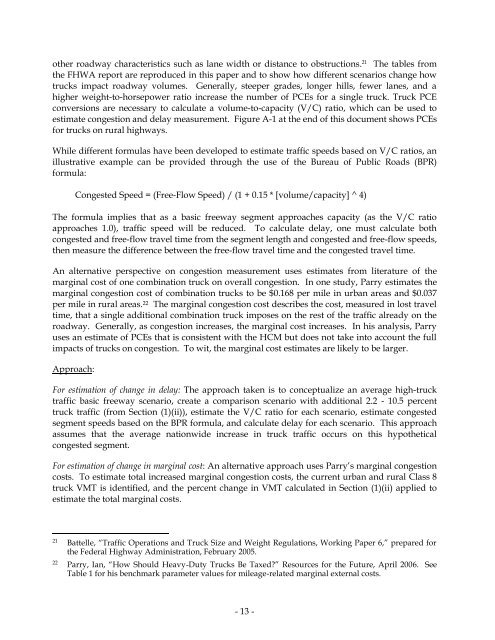Assessment of Fuel Economy Technologies for Medium and Heavy ...
Assessment of Fuel Economy Technologies for Medium and Heavy ...
Assessment of Fuel Economy Technologies for Medium and Heavy ...
You also want an ePaper? Increase the reach of your titles
YUMPU automatically turns print PDFs into web optimized ePapers that Google loves.
other roadway characteristics such as lane width or distance to obstructions. 21 The tables from<br />
the FHWA report are reproduced in this paper <strong>and</strong> to show how different scenarios change how<br />
trucks impact roadway volumes. Generally, steeper grades, longer hills, fewer lanes, <strong>and</strong> a<br />
higher weight-to-horsepower ratio increase the number <strong>of</strong> PCEs <strong>for</strong> a single truck. Truck PCE<br />
conversions are necessary to calculate a volume-to-capacity (V/C) ratio, which can be used to<br />
estimate congestion <strong>and</strong> delay measurement. Figure A-1 at the end <strong>of</strong> this document shows PCEs<br />
<strong>for</strong> trucks on rural highways.<br />
While different <strong>for</strong>mulas have been developed to estimate traffic speeds based on V/C ratios, an<br />
illustrative example can be provided through the use <strong>of</strong> the Bureau <strong>of</strong> Public Roads (BPR)<br />
<strong>for</strong>mula:<br />
Congested Speed = (Free-Flow Speed) / (1 + 0.15 * [volume/capacity] ^ 4)<br />
The <strong>for</strong>mula implies that as a basic freeway segment approaches capacity (as the V/C ratio<br />
approaches 1.0), traffic speed will be reduced. To calculate delay, one must calculate both<br />
congested <strong>and</strong> free-flow travel time from the segment length <strong>and</strong> congested <strong>and</strong> free-flow speeds,<br />
then measure the difference between the free-flow travel time <strong>and</strong> the congested travel time.<br />
An alternative perspective on congestion measurement uses estimates from literature <strong>of</strong> the<br />
marginal cost <strong>of</strong> one combination truck on overall congestion. In one study, Parry estimates the<br />
marginal congestion cost <strong>of</strong> combination trucks to be $0.168 per mile in urban areas <strong>and</strong> $0.037<br />
per mile in rural areas. 22 The marginal congestion cost describes the cost, measured in lost travel<br />
time, that a single additional combination truck imposes on the rest <strong>of</strong> the traffic already on the<br />
roadway. Generally, as congestion increases, the marginal cost increases. In his analysis, Parry<br />
uses an estimate <strong>of</strong> PCEs that is consistent with the HCM but does not take into account the full<br />
impacts <strong>of</strong> trucks on congestion. To wit, the marginal cost estimates are likely to be larger.<br />
Approach:<br />
For estimation <strong>of</strong> change in delay: The approach taken is to conceptualize an average high-truck<br />
traffic basic freeway scenario, create a comparison scenario with additional 2.2 - 10.5 percent<br />
truck traffic (from Section (1)(ii)), estimate the V/C ratio <strong>for</strong> each scenario, estimate congested<br />
segment speeds based on the BPR <strong>for</strong>mula, <strong>and</strong> calculate delay <strong>for</strong> each scenario. This approach<br />
assumes that the average nationwide increase in truck traffic occurs on this hypothetical<br />
congested segment.<br />
For estimation <strong>of</strong> change in marginal cost: An alternative approach uses Parry‘s marginal congestion<br />
costs. To estimate total increased marginal congestion costs, the current urban <strong>and</strong> rural Class 8<br />
truck VMT is identified, <strong>and</strong> the percent change in VMT calculated in Section (1)(ii) applied to<br />
estimate the total marginal costs.<br />
21<br />
Battelle, ―Traffic Operations <strong>and</strong> Truck Size <strong>and</strong> Weight Regulations, Working Paper 6,‖ prepared <strong>for</strong><br />
the Federal Highway Administration, February 2005.<br />
22<br />
Parry, Ian, ―How Should <strong>Heavy</strong>-Duty Trucks Be Taxed‖ Resources <strong>for</strong> the Future, April 2006. See<br />
Table 1 <strong>for</strong> his benchmark parameter values <strong>for</strong> mileage-related marginal external costs.<br />
- 13 -
















